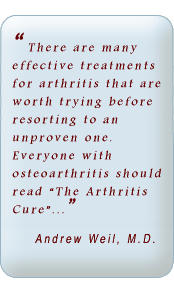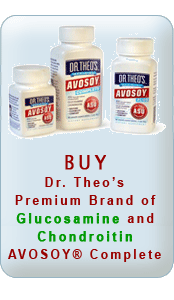Medical Evidence
Glucosamine Basic Science Studies
Chondroitin Basic Science Studies
Glucosamine Clinical (Human) Studies
Chondroitin Clinical (Human) Studies
Combined Clinical (Human) Studies
Review Articles on Glucosamine
Review Articles on Chondroitin
Home Page
News
Supplements
Resources
Products
Books
Q & A
About Dr. Theo
 
|
Key Points in the Glucosamine/Chondroitin Arthritis Intervention Trial (GAIT)
Glucosamine and Chondroitin have extensive, World-Wide acceptance
GAIT is one of over 30 studies worldwide on glucosamine and chondroitin
Glucosamine is a prescription or over-the counter drug in 56 countries.
Chondroitin is a prescription or over-the counter drug in 22 countries
The costs for glucosamine and chondroitin are often subsidized or reimbursed by insurers and government health plans.
The European Union recognizes glucosamine and chondroitin as having the highest level of evidence (1A category) and
highest recommendation (A) of all treatments for osteoarthritis. Evidence for COX-2 drugs like Celebrex are listed as a step below (1B evidence category)
The exact same glucosamine and chondroitin ingredients used as drugs internationally are available as supplements (non-prescription) in the U.S.
Unlike other supplements, glucosamine and chondroitin have long-term outcome measures in arthritis patients:
– 75% reduction in joint replacements compared to placebo when taken for ≥ 3 years
– 67% reduction in the need for anti-inflammatory drugs
– Decreased need for other medications, physical therapy and surgery so effectively that overall, users save substantial amounts of money
GAIT Study Design
1,583 subjects with knee osteoarthritis, 6 months treatment duration, split in 5 groups:
– Glucosamine alone
– Chondroitin alone
– Glucosamine + Chondroitin
– Placebo (negative comparator)
– Celebrex (positive comparator)
Because each treatment was compared separately to placebo and not to each other, if the placebo rate was high, the treatments didn’t look like they performed as well. The placebo rate was extraordinarily high at 60%. The authors had predicted a 35% placebo response (normal average in most studies.)
Why was the placebo rate so high?
1. Subjects were given 7 capsules per day (6 supplements or 6 placebo and 1 Celebrex or 1 Placebo) split over three times daily. If you took that many capsules, you’d think you’re getting something.
2. Subjects knew at the start that they had a 4/5 chance of being put into a treatment (and not placebo) group
3. Subjects were called every week for compliance (more frequent contact is known to increase placebo rate)
The study should probably have been called inconclusive or void because the active drug failed to beat placebo in 48 or the 52 separate outcome measures (outcomes listed in NEJM v.352, no.8 pp. 800-5.)
View the chart of all of the outcome measures that were statistically significant
Since Celebrex beat placebo at a much higher rate in more than a dozen other, larger studies, the GAIT study was flawed and invalid. Positive comparators (treatments generally known to have effects) are used to gauge the validity of a study. If the positive comparator fails, the study can’t be right.
Key findings in the GAIT results
Of all 52 outcome measures in GAIT…
The most effective result was glucosamine + chondroitin for those with moderate to severe pain: 79.2% had significant relief
The most statistically significant result was glucosamine + chondroitin for those with moderate to severe pain: p = 0.001 (meaning 99.9% probability that this result is real and not due to chance).
The supplements’ effects generally increased each successive month of the six-month evaluation. This shows that all glucosamine/chondroitin studies of shorter duration have understated their effects and should be deemed invalid. (Some drug researchers are trying to discredit glucosamine by highlighting some glucosamine studies that were too short in duration to show the full effect of glucosamine.)
Celebrex was more effective in those with mild/moderate pain (the patients we try not to give drugs in clinical practice). 78% of the subjects fell into this group. Glucosamine + chondroitin worked best in those with clinically significant pain (22% of the subjects). Since the overall results were the combination of the two groups, the study was heavily skewed toward the mild/moderate pain patients.
In clinical practice, patients with moderate/severe pain are they are more likely to miss work, need therapy or surgery. They make up the bulk of the tens of $billions in direct and indirect costs of arthritis care. To have a treatment that successfully treats 79.2% of these patients, as was shown for glucosamine + chondroitin in GAIT, is a major breakthrough. This is the key headline. It’s a shame when medical politics interferes with the care of the patient and with public health as a whole.
Jason Theodosakis, MD, MS, MPH, FACPM
Assistant Professor, University of Arizona College of Medicine
Steering Oversight Committee, GAIT
|

Learn about and purchase the book90% of people who follow The Arthritis Cure treatment program don't need anti-inflammatories (like Aleve, Celebrex or Advil).
Dr. Theo warned people that these drugs, used first... read more
|
|




